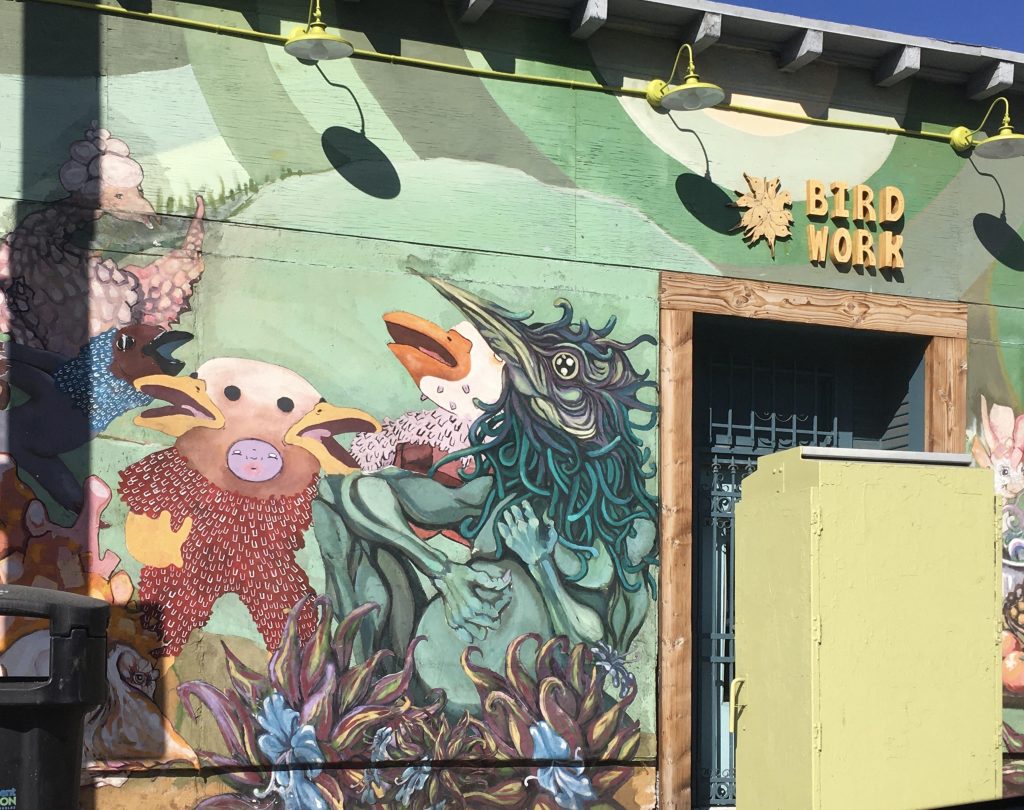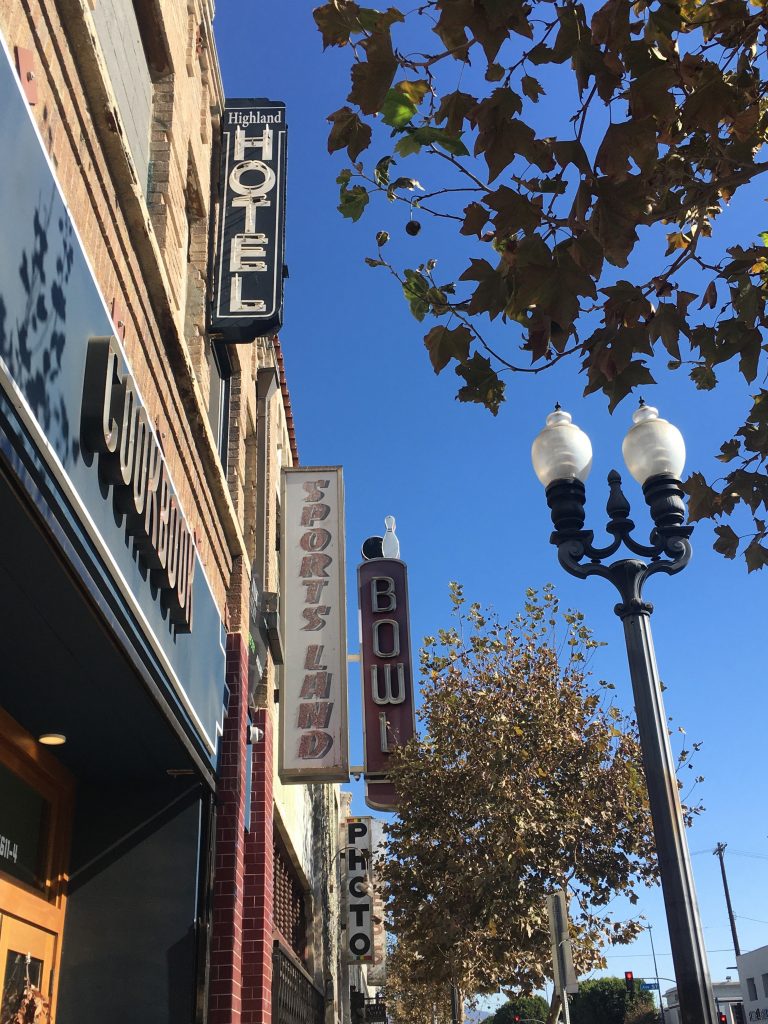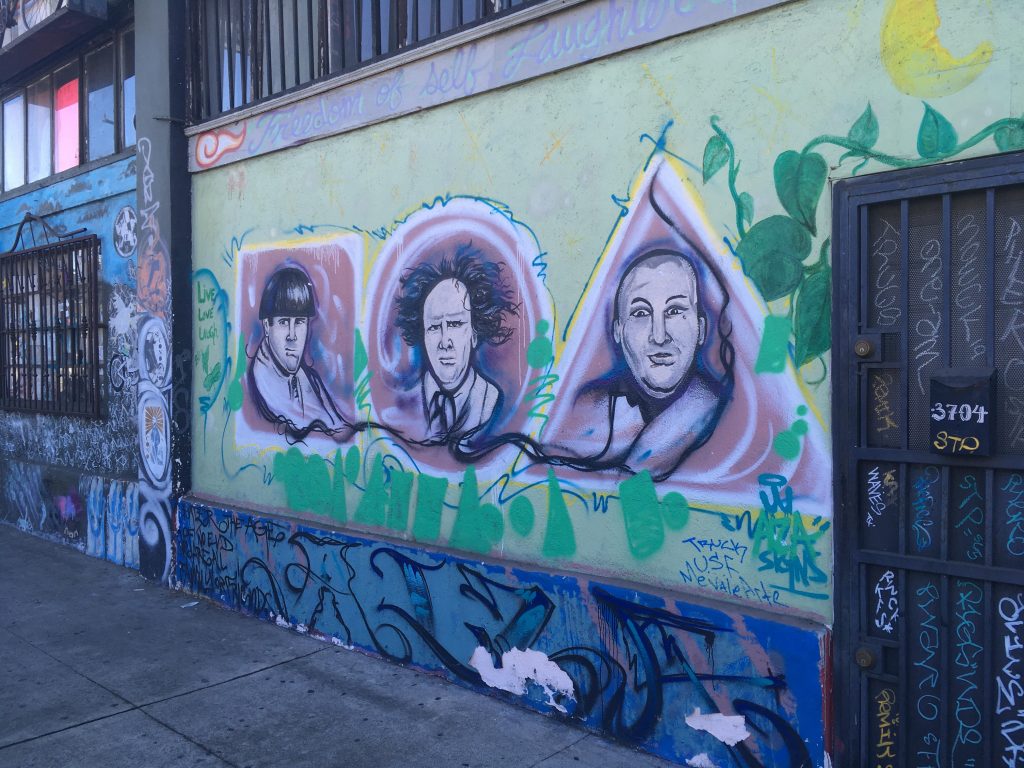Los Angeles signage is my favorite folk art.
Often sun-soaked and peeling, the freehand paintings suggest both history and care, as well as the possibility — or memory — of a world unspoiled by corporate advertising. I love driving through the city and spotting unlicensed, slightly altered images of Mickey Mouse or the Simpsons eating ice cream on the side of a truck, or smiling teeth dancing across a ribbon of tooth paste, or an asymmetrical sandwich bursting with unspecified meats.

The signs are sometimes utilitarian, like the community church store on Eagle Rock Boulevard, where paintings depict the items they sell: bags of chips, bottles of soap, Gatorade. Some are more imaginative, like Rambo’s Tacos truck, where Rambo, shirtless and wearing a belt of bullets, holds a plate of tacos while being shot at from a sniper plane. A bullet has just sprayed through his cup of soda and a dish of red salsa is rendered mid-spill. A mural of the Three Stooges graces the wall of La Abeja, a Mexican restaurant up the street from my apartment in Cypress Park, beside a wraparound mural of Aztec iconography. One of the Eastside’s most iconic signs — the rotating Happy/Sad Foot sign on Sunset — has even come to colloquially define a neighborhood (HaFoSaFo). Outrage erupted when the business moved this past summer, taking the sign down when they left.
Sometimes I pull over to take a photo of my favorites, when it’s golden hour and the lighting is right. It’s a specific kind of warmth, like when a lover does something so endearing you feel lucky to have witnessed it.
¤
Growing up in Boston, the Citgo sign has always been an integral fixture of our city. It can be seen in the background of Red Sox games at Fenway Park and is prominently featured in every depiction of the skyline. The 60×60 foot structure looms over Kenmore Square. It lights up, too. The white background flickers up and down, holding the red and orange triangle, the word “CITGO” in blue retro block letters beneath.
The orange triangle served as a lighthouse on long drives throughout my childhood. I’d know that we were almost home when I caught a glimpse of it driving up the Mass Pike to Revere. It seemed that no matter where we were returning from, we always passed the Citgo sign.
The original sign was installed in 1940, updated 1965, and restored in 2005, when the lights were converted to LED. Public advocacy prevented the city from removing the sign in 1983, and led to its designation as a historical landmark.
Citgo is a petroleum corporation owned by PDVSA, a state-owned company of the Venezuelan government (although due to US sanctions, in 2019, Venezuela no longer economically benefits from Citgo). It took me years to notice there isn’t even a Citgo station beneath the sign. For most of my childhood, it was a Bertucci’s.
In September 2006, Boston city councilor Jerry McDermott proposed that the sign be removed in response to Hugo Chávez’s insults toward President George W. Bush. McDermott also suggested draping an American flag or Boston Red Sox banner over the sign until Chávez was out of office. Thankfully, neither occurred.
If you ask any Bostonian, though, the signified has divorced almost completely from signifier. No one in Boston sees Citgo and thinks oil. Instead, we think home.
¤
In Thom Anderson’s 2003 film Los Angeles Plays Itself, Anderson writes: “I find the Hollywood sign reassuring. Maybe I find it poignant that a decayed advertisement for a real estate development could become a civic landmark.”
The Wells Fargo branch near the restaurant where I work is decorated with a large collage of images from Silver Lake’s history. A photograph of the reservoir depicts nearly empty hillsides, now cluttered with expensive houses. The collage includes the famous music box stairs, Dodger Stadium, Taix French Restaurant (which has recently been purchased by luxury apartment developers) and, my favorite, two protestors standing beneath The Black Cat (site of a historic LGBT protest, now pricey gastropub) holding signs that say “Peace in Silverlake.”
Even the wallpaper in the McDonalds near my house is made up of photos of older McDonalds.
Anderson, again: “Although Los Angeles is a city with no history, nostalgia has always been the dominant note in the city’s image of itself. At any time in its history, Los Angeles was always a better place ‘a long time ago’ than in the present.”

When I first moved to Los Angeles, I met my friend Jamie for a drink in Highland Park. “That’s the first Forever 21,” he told me as we walked from the car, pointing to a nondescript sign on a corner. The red block letters said Fashion 21.
“Wait, really?” I said, looking up, skeptical.
He laughed.
“Why would I make up something so dumb?”
¤
My least favorite sign in Los Angeles lives around the corner from me, set back on a mostly quiet, mostly residential street. “DEN,” the sign reads in a clean, sans-serif font, “an urban dog retreat.” Beneath, its slogan: “the ultimate in dog wellness.”
This sign has come to stand in for the worst of the worst gentrification establishments cropping up all over this side of town in recent years.
A trip to the DEN website lists their services and testimonials. In addition to basics, like training, daycare, and grooming services, DEN offers “holistic care” including doggy meditation, essential oils, and therapy to “awaken your dog’s spirit.” One may enter the code “Paw-Mastay” at checkout for a discount.
DEN’s front wall was tagged consistently for months after it opened. The owners seemed to tire of painting over the graffiti, so they hired an artist to paint a mural instead. Pink flowers and green vines, with the artist’s name signed daintily in the bottom right corner. The mural hasn’t been defaced yet, but part of me hopes it is, eventually. I’ve noticed a cop car parked by the wall for the past several nights, and I wonder if DEN contracted them “to protect and serve.” (A favorite Anderson line: Is there any other city where the police put their motto in quotation marks? Are they trying to be ironic?)
Sometimes I think it’s too easy to hate businesses like DEN, whose copy reads like a Portlandia sketch, but then I read about the family-run typewriter repair shop up the street on Figueroa, which was forced to close this year after a 250% rent increase. Borrowing from anti-police protest chants, businesses like DEN raise the question whom do you serve?
The truth, though, is that I haven’t been here much longer than DEN, and I wonder if my white hipster presence feels just as garish.
One night last summer I sat on my friend’s porch in a small group, chatting while they smoked. A man walked up to the gate.
“You live here?” he asked.
Someone nodded. “Do you?”
He gestured across the street. “My whole life,” he said.
A pause, then again: “My whole life.”
An ugly silence lingered in the static of the warm night until someone said, “Thanks for having us in the neighborhood!” which felt strange and wrong, but even now, I can’t quite think of anything better.
¤
On the neighborhood website Nextdoor, someone suggests petitioning for a Trader Joe’s to move into the retail space recently vacated by the local chain Big Saver Foods. A community member named Howard writes, “Instead of asking for yet another market, I suggest you contact your local reps and demand a strip club. Help bring the arts back to Highland Park.” I can’t decide if the comment is a joke.
A few weeks ago, an off-duty police officer was shot and killed at a local taco stand. Someone on Nextdoor asked if anyone knew what all the “ghetto birds” (helicopters) were hovering for.

When I noticed a Starbucks was opening up across the street from my apartment, I rolled my eyes. But now I stop there often, even though I live above a locally owned coffee shop. I hide my Starbucks cup under a sweater whenever I walk by.
¤
I used to work as a research assistant for a professor who studied Los Angeles history and its forgetting. I’d sit in the back room of his Highland Park craftsman surrounded by books I was supposed to be organizing. When I finished, I drew a map explaining the archival system I’d created. The next time I visited, he had lost it.
Driving home from his house, I often passed a shuttered pharmacy with an orange and blue sign that said OWL. Months later, the grates had been painted pink with cutesy owls, in a decidedly Urban Outfitters aesthetic. When the space reopened as The Owl Bureau, new marquees were placed on either side of the same OWL Drugs sign. The one on the left read, “We could be heroes, just for one day.” The storefront windows were filled with identical copies of a David Bowie album.
I wandered inside once while killing time before my haircut across the street. It’s an art bookstore, I realized, and each book I picked up cost over fifty dollars. Neither of the two employees asked if I needed help, probably guessing I wouldn’t purchase anything. The décor inside is minimalist and cold, like many other new-agey craft and design stores that have opened on this strip. The shelves are porous, and through the round holes I could see people on the other side sitting in a cooperative work space, with sleek Macs and mock-up boards.
A Los Angeles Times article about the store explains that the owner, Richard Christiansen, uses the back room to house the West Coast office of his “full service advertising and media agency.”
The piece also notes that Christansen felt instantly connected to the space and “when he discovered the drugstore’s owner, Hong Kong immigrant Mei Cheung, also collected owls… it sealed the deal.”
Maintaining OWL’s original sign utilizes an aesthetic of authenticity to manipulate the memories and associations of neighborhood patrons. This practice feels, to me, even more violent than if they’d paved over the past entirely.
Since moving from New York, Christansen says, “I didn’t feel like anyone was wrapping their arms around all these amazing creative people here in California, the doorstep of the world’s imagination, and doing it through design and art and fashion.” Never mind the creativity, art, and fashion that existed long before his move.
¤
Walking down Figueroa is strange. About half the storefronts (maybe less now) are long-standing, mostly Latinx businesses. The rest is sparse, high-end retail. On a hot summer day, I decide to count all the signs for establishments that are no longer there. I’ve been interested in this practice since I noticed it, which I haven’t recognized anywhere else.

Sportsland, Frank’s Camera, HSM Swap Mall, Manning’s Coffee Store, an unnamed dress shop above Civil Coffee. The signs are there, though the establishments have long changed over. It feels like a metaphor, but I’m not sure for what.
Chicken Boy, a 22-foot statue of a chicken wearing jeans, has become an unofficial mascot of Highland Park, though it’s only stood on its Figueroa perch since 2007. It was originally situated above a fried chicken restaurant downtown, on Broadway.
Good Housekeeping, a semi-secret bar behind the first Forever 21, is named after the old Good Housekeeping advertisement painted on the wall in the parking lot outside. Highland Park Bowl was a massive preservation project to revitalize the 1927 Prohibition-era bowling alley. Now it resembles something of an urban ruin, which happens to serve $15 cocktails (as does Good Housekeeping).
¤
An excerpted Yelp review for Barcade, a New York-based chain with a new location on York Boulevard:
July 1, 2019
It is so tacky they left the original “El Arco Iris” sign up. Like do you really think you are paying tribute to the building’s history or its neighborhood identity? Just own up to the fact you are a business in a gentrifying neighborhood.
¤
Los Angeles is often mythologized as a place with no history, but in fact it contains layers upon layers, many of which are actively being erased. It is, in fact, stolen Tongva land, first and foremost.
How does one write about a place?
If I write about the things I see, will that approach a story of Los Angeles?

My friend Sam invites me to a bar he’d read about online. “It looks cute and summery,” he says. The internet tells us the bar is in Little Tokyo, but as we walk there from the gold line, we realize it’s more like Skid Row. A block away, sprinklers spray water steadily onto the sidewalk, to keep people from sleeping there or to wash after people have slept there, either way violent. We show our IDs to the bouncer and pass through a pink patio, made for Instagram. Inside, a DJ plays thumping dance music to a room of two people. We realize the menu is beer and wine only. Slushy drinks spin in a machine on the counter like the slurpees at 7/11. We order two, pay the standard $14 each, and get brain freezes.


